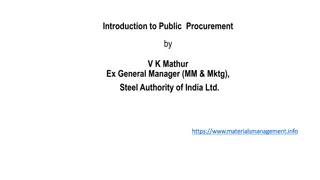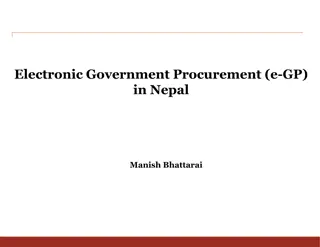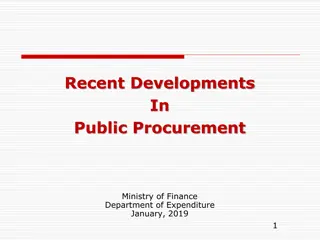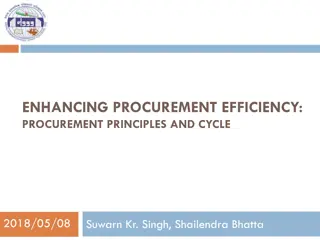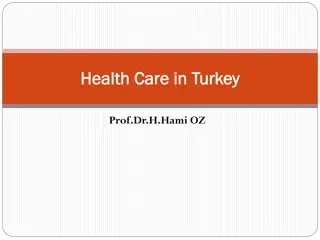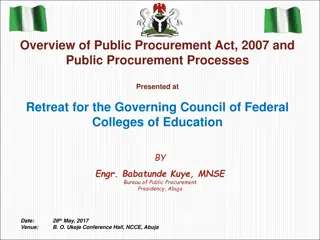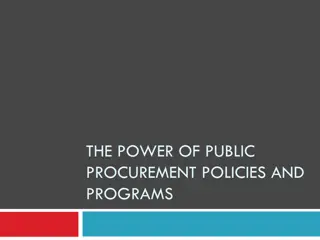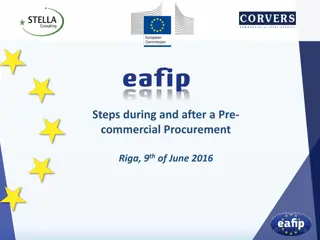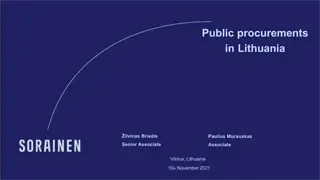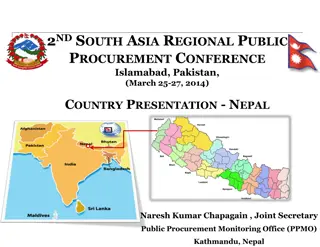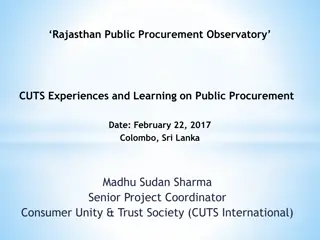Measuring Performance of Public Procurement in Turkey: Challenges and Solutions
Public procurement is a critical aspect of a country's economy, including Turkey. The efficiency and effectiveness of the Turkish Public Procurement System are essential for maximizing value for money and utilizing public resources optimally. This article discusses the historical foundations, current regulations, and the importance of measuring performance in Turkish public procurement. Challenges and opportunities in the system are also highlighted.
Download Presentation

Please find below an Image/Link to download the presentation.
The content on the website is provided AS IS for your information and personal use only. It may not be sold, licensed, or shared on other websites without obtaining consent from the author.If you encounter any issues during the download, it is possible that the publisher has removed the file from their server.
You are allowed to download the files provided on this website for personal or commercial use, subject to the condition that they are used lawfully. All files are the property of their respective owners.
The content on the website is provided AS IS for your information and personal use only. It may not be sold, licensed, or shared on other websites without obtaining consent from the author.
E N D
Presentation Transcript
Measuring Performance of Public Procurement in Turkey Public Procurement Authority Department of International Relations
Agenda Introduction Public Procurement System in Turkey Measuring Performance in Turkish Public Procurement System E-Procurement and Business Intelligence Measuring Performance (cont.) Challenges Q & A
Introduction Public Procurement accounts for a significant share of gross domestic product of countries (EU average is %19 of the GDP). Therefore, effective, transparent and competitive public system is of paramount importance in terms of effective use of public resources. Performance of public procurement should be measured to see whether the procurement efficiently in accordance with the objectives set. procurement system works
Introduction Value for money (VFM) is defined by business dictionary; A utility derived from every purchase or every sum of money spent. On the other hand, value for money is based not only on the minimum purchase price (economy) but also on the maximum efficiency and effectiveness of the purchase. So that VFM is crucial for the measurement of performance of public procurement. http://www.sentinelha.org.uk/images/charts/VFM2.bmp http://static.guim.co.uk/sys-images/Guardian/Pix/pictures/2012/3/30/1333118491685/coins-on-scales-008.jpg
Turkish Public Procurement System (TPPS) Turkish Public Procurement Sytem has four historical cornerstones: 1) Auction, Contest and Tender Law no 661 dated 22 April 1925 2) Auction and Tender Act no 2490 dated 10 December 1934 3) State Tender Law no 2886 dated 08 September 1983 4) Public Procurement Law (PPL) no 4734 dated 04 January 2002 http://im.haberturk.com/2012/02/13/715474_detay.jpg?1329135467 PPL has created an advanced model of international procurement regulations.
Turkish Public Procurement System (TPPS) Currently, Public procurement is regulated by Public Procurement Law No. 4734 which entered into force on January 1, 2003. One of the objectives of preparing a new law on public procurement was adaptation to international instruments on public procurement (EU Procurement Directives, UNCITRAL Model Law on Procurement, World Bank Procurement Guidelines, etc.). http://www.uzdaily.com/img/banks/world_bank_logo.jpg http://www.brazil-works.com/wp-content/uploads/2012/09/WTO-Logo.jpg http://www.dimiter.eu/thumb/eu.png Public Procurement Law no. 4734 http://t2.gstatic.com/images?q=tbn:ANd9GcQgBXoWkOEpx25CxYIcbQXGXvXudP13PZFIGauzYdUDiPyQUank
Methodology of Measuring Performance National Level (Meta Level) Macro Level Micro Level Overall Evaluation in Three Parameters
Measuring Performance Number of Advices Provided by the PPA 1,400 Regulation attended 63 meetings in order to implementation of public procurement in 2013. Department 1,200 Number of requests for advice Number of replies by the PPA 1,000 guide the 800 600 legislation 400 200 0 Average time period for resolving disputes after submission of complaints 100% 80% 60% More than 30 days Less than 30 days 40% 20% 0% 2012 2013
Measuring Performance Macro Level Number of Procurement Value of Procurement 140000 125,000,000,000 120000 100,000,000,000 100000 75,000,000,000 80000 60000 50,000,000,000 40000 25,000,000,000 20000 0 0 2012 2013 2012 2013 Duration of Procurement Process 100 Average days between publication of contract notice and signing of contract in above- threshold contracts 80 60 40 20 0 2012 2013
E-Procurement http://www.idriskurtum.com.tr/wp-content/uploads/2011/04/EkapKsp.png Electronic Public Procurement Platform (EPPP) became operational on 1 September 2010. All transactions relating to public procurement are through or registered on EPPP. carried out Operations that can be performed in EPPP include publication of contract notices, preparation of contract document, downloading the contract document, verification of tax liability, balance sheet and income statement information, social security premium debt information of the economic operators.
Measuring Performance Savings achieved by using Electronic Public Procurement Platform: Contracting Authorities Savings due to less printing of tender documents (350.000 tender documents, avg. 50 pages, cost per page0,2 TL) 3,5 million TL (1,15 million ) Time savings (11 person/day, daily cost 50TL, 150.000 tenders annually) 82,5 million TL (27 million ) Contract Value Savings (Contract Value/Estimated Cost Ratio decreased from 81% to 74%, average number of tenders increased from 3,3 to 5,6 in 2011 and from 2,6 to 5,1 in 2012 ) Approximately 1,5 billion TL annually 1,6 billion TL (520 million ) TOTAL REALIZED SAVINGS (yearly)
Measuring Performance Savings achieved by using Electronic Public Procurement Platform: Economic Operators Savings due to tender document acquisition (yearly) (350.000 tender documents* document price) 54 million TL (18 million ) Transportation savings (yearly) (350.000 tender documents* 10 TL/tender document) 3,5 million TL (1,15 million ) Time Savings (yearly) (350.000 tender documents* 1 man/day*35 TL daily) 12,2 million TL (4 million ) 69,7 million TL (22,6 million ) TOTAL REALIZED SAVINGS (yearly)
Business Intelligence A business intelligence application was put into use on Electronic Public Procurement Platform in order to: gather statistical data about public procurement for business processes analysis, standardize analysis of public procurement data and development of public procurement reports, faster retrieve up to date and instant data, more effectively provide procurement data to the other units of PPA, provide statistical information within the scope of The Law of Info Access Rights No. 4982 , provide information to contracting entities, economic operators and public in a visually rich and dynamic way, improve public procurement processes by employing data mining.
Measuring Performance Use of Competitive Procedures 100,000,000,000 90,000,000,000 Competitive procedures should be used as much as possible competition transparency. 80,000,000,000 Competitive procedures (open, restricted and negotiated procedures) Non-competitive procedures (direct procurement) for and 70,000,000,000 60,000,000,000 50,000,000,000 In 2013, 93,28% of all public contracts subject to the PPL are awarded using procedures. 40,000,000,000 30,000,000,000 competitive 20,000,000,000 10,000,000,000 0 2012 2013
Measuring Performance Savings Average percentage of savings should be as high as possible to achieve best value for money. 140,000,000,000 120,000,000,000 100,000,000,000 In cost / contract value ratio was 76%. 2013, estimated 80,000,000,000 Estimated cost Contract value 60,000,000,000 The graph shows that through competitive procedures how much saving was achieved based on estimated cost / contract value comparison. 40,000,000,000 using 20,000,000,000 0 2012 2013
Measuring Performance Use of EPPP by Economic Operators to Obtain Tender Document 70.00% 60.00% Tender documents acquired directly from the contracting authorities Tender documents acquired through EPPP by using e-signature or m- signature Use of electronic tools must be encouraged for the efficiency of the procurement system. 50.00% 40.00% 30.00% The graph shows that the use of EPPP is very common economic operators. 20.00% among 10.00% 0.00% 2012 2013
Measuring Performance Average Participation Rate 7.00 Average rate procurement should be high as possible to competition. participation to 6.00 public 5.00 much as Goods Works Services Total ensure 4.00 3.00 2.00 In 2013 average number of tenders per public contract was 4,21. 1.00 0.00 2012 2013
Measuring Performance Number of Complaints to the PPA 140,000 An efficient review and remedies system should be established to ensure compliance contracting authorities. 120,000 by the 100,000 Number of contracts that can be appealed Number of complaints to the PPA 80,000 In 2013, 95,64% of public contracts were awarded without any dispute. 60,000 40,000 Total complaints which constitutes 4,36% of all contracts that can be appealed in 2013. number was of 5.093, 20,000 0 2012 2013
Measuring Performance Decisions of the PPA The graph shows the decisions of the PPA upon complaints. 70.0% Rejection of complaint 60.0% The PPA reviews and concludes complaints within 20 days after necessary documents are received. Corrective action 50.0% the 40.0% all the Annulment of procurement proceeding Annulment of termination of procurement No need to take a decision 30.0% 20.0% In 2012 and 2013, more than half of the complaints rejected. 10.0% were 0.0% 2012 2013
Measuring Performance Performance of Review by the PPA 6000 The graph shows the number of decisions of the PPA challenged before the courts and the results of the legal proceedings. 5000 Total number of decisions of the PPA Decisions challenged before the courts Court decisions overruling PPA's decisions 4000 3000 In 2013, 84,66% of decisions of the PPA was not before the which shows that a large majority stakeholders satisfied review by the PPA. 2000 challenged courts 1000 of 0 are the 2012 2013 with
Measuring Performance Micro Level Procurement of Works Former Legislation New Legislation Average completion period of projects Completion of projects without cost overrun Participation to procurement L H H L L H Former legislation denotes State Procurement Law no. 2886 and new legilation denotes Public Procurement Law no. 4734 which is mostly in line with international regulations.
Overall Micro Level Macro Level Meta Level Efficiency High Neutral High Transparency High High High Equal Treatment High High High
Challenges New Developments Amendments to legislation, EU Directives, GPA, etc. Capacity Administrative capacity in contracting authorities and economic operators Sustainability Sustainability of procurement performance
How to Deal With Challenges More Innovative Procurement Green Social Concerns Integration to International Regulations Procurement http://londongigabyte.com/images/lg.com.approach.jpg http://www.cnmoony.com/static_res/ProcurementGraph.jpg
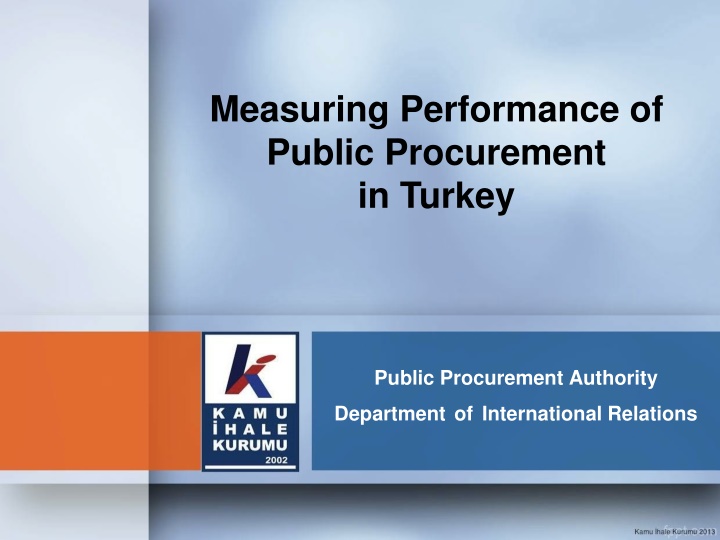


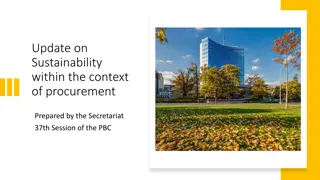
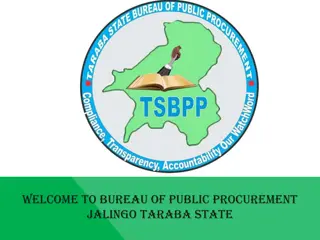
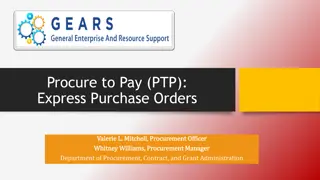
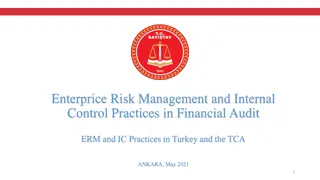
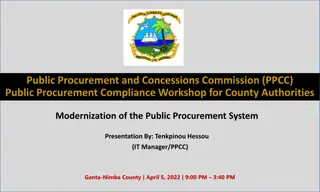
![Comprehensive Overview of Corruption Watch Submission on Public Procurement Bill [B18B-2023]](/thumb/138344/comprehensive-overview-of-corruption-watch-submission-on-public-procurement-bill-b18b-2023.jpg)
